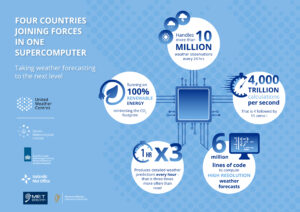The National Meteorological Institutes of Ireland, Denmark, Iceland and the Netherlands have joined forces to respond to climate change with more timely weather forecasting on a new, now operational, common supercomputer. This helps prepare each nation for the impacts of weather patterns, which are expected to become more extreme and more challenging to forecast.
23rd September 2024

Fig 1: The new ‘United Weather Centres West’ weather forecasting supercomputer, located in Iceland
The ‘United Weather Centres West’ collaboration (UWC-West) between the National Meteorological Services of Ireland, Denmark, Iceland and the Netherlands has entered its operational phase and is now running a common weather forecasting model on a new supercomputer, located in Iceland, supporting the provision of state-of-the-art services to society in a changing climate.
Building on five years of close collaboration between the four National Meteorological Services and improved common computational capabilities, this supercomputer calculates forecasts at a higher level of detail for a much larger area than before. Powered entirely by renewable Icelandic hydropower and geothermal energy sources, the running costs and CO2 footprint will be kept to a minimum, as part of the institutes’ contributions towards net-zero.
Eoin Moran, Director of Met Éireann, says: “Pulling together the expertise from our four countries allows us to prepare for the future faster and more efficiently. Making our common forecasting system operational is the culmination of five years of intense cooperation on computer and models by the four institutes. It represents not only a technical achievement but the confirmation that joining expertise and experience can lead to greater things. My colleagues in Denmark, Iceland and the Netherlands all agree that, through the UWC-West collaboration, we are paving new ways for weather services to work”.
Commenting on the benefits of the new model, Eoin Sherlock, Head of Forecasting at Met Éireann, says: “Overall, this new model version allows us to get a better handle on the uncertainty of the predictions. Numerical Weather Prediction (NWP) models are run a number of times with slightly different initial conditions, each of these then providing slightly different outcomes. This is known as an Ensemble Prediction System (EPS) and Met Éireann’s previous operational model consisted of fifteen EPS “members”, or individual runs. With the new supercomputer, we have doubled that number, so our probabilistic analyses and the forecasters’ understanding of complex scenarios will certainly benefit from that”.
Understanding weather and climate has never been more important. The latest reports from the IPCC and the WMO show that climate change is already causing more heatwaves, floods, and heavy rainfall around the world. These events are becoming more frequent and intense due to global warming caused by human activities, “All the experts who made this project possible acknowledge that by working together, the four national institutes can now respond better to weather events, helping to protect lives, property, and make smarter decisions as our climate continues to change”, explains Eoin Moran.
While the system is now operational, the UWC-West collaboration doesn’t stop here. The four National Meteorological Services keep on working together on continuously evolving and improving the common forecasting model and implementing the latest improvements on it.
Eoin Moran says: “The powerful collaboration we have started is here to stay. The advancements of weather and climate research, on AI, big data and computing technology make our collaboration more needed than ever. Together we will gain more knowledge, push our weather models further and share much more data than before.”

Fig 2: Objectives of the UWC-West collaboration
New model coverage and characteristics
The new NWP model is based on the Harmonie-Arome source code that Met Éireann has been developing in collaboration with many other met services since more than two decades and using operationally (in different upgraded versions) since 2011.
The new model domain extensively covers an area from East Greenland to southern Italy, dividing the geographical area in squares of 2km in size, an improvement compared to the previous 2.5km grid of the previous model version Met Éireann operated. The model represents the atmosphere vertically in the form of 90 levels, a substantial increase from the 65 levels of the previous operational model. These are resolution improvements which translate into better representation of the meteorological parameters across the domain.
The new model is running every hour, while the previous computing capabilities allowed to run it every three hours. This means more timely model updates to the forecasters, feeding the Met Éireann processes for updating the forecast and issuing warnings.

Fig 3: The United Weather Centres West collaboration has created a new weather model with two forecasting domains, covering the four countries’ areas of interest. Red area shows the Iceland and Greenland domain, blue area shows the Ireland, Denmark, Iceland, and the Netherlands domain.
Facts | Climate/weather models and computational capability
- Weather forecasts are based on extensive observations from satellites, radars, weather balloons, ground station sensors, and a variety of other sources.
- NWP models simulate the atmosphere using complex codes and equations.
- NWP models are run a number of times with slightly different initial conditions. This allows to understand prediction uncertainties and is known as an Ensemble Prediction System (EPS).
- High computational capability is crucial for both weather forecasting and climate modelling.
Facts | United Weather Centres West
- Collaboration between the National Meteorological Services (NMSs) of Ireland, Denmark, Iceland and the Netherlands
- Collaboration established in 2019
- Procured a common supercomputing system, consisting of two units, one dedicated to operational weather forecasting and another one dedicated to climate research.
- Supercomputer location: Iceland
- Energy Source: Renewable Icelandic hydropower and geothermal energy
- Developed a common Numerical Weather Prediction (NWP) model system
- NWP model resolution: 2×2 km horizontally, 90 vertical levels
- NWP model update frequency: hourly, with 30 EPS members running every 6 hours.
- The four NMSs commonly operate and maintain the supercomputer and model system

Fig 4: UWC-West supercomputer facts